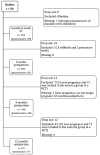Diastasis recti abdominis during pregnancy and 12 months after childbirth: prevalence, risk factors and report of lumbopelvic pain
- PMID: 27324871
- PMCID: PMC5013086
- DOI: 10.1136/bjsports-2016-096065
Diastasis recti abdominis during pregnancy and 12 months after childbirth: prevalence, risk factors and report of lumbopelvic pain
Abstract
Background/aim: Diastasis recti abdominis (DRA) is defined as a separation of the 2 muscle bellies of rectus abdominis. To date there is scant knowledge on prevalence, risk factors, and consequences of the condition. The present study aimed to investigate the prevalence of DRA during pregnancy and post partum, presence of possible risk factors, and the occurrence of lumbopelvic pain among women with and without DRA.
Methods: This prospective cohort study followed 300 first-time pregnant women from pregnancy till 12 months post partum. Data were collected by electronic questionnaire and clinical examinations. DRA was defined as a palpated separation of ≥2 fingerbreadths either 4.5 cm above, at or 4.5 cm below the umbilicus. Women with and without DRA were compared with independent samples Student's t-test and χ(2)/Fisher exact test, and OR with significance level >0.05.
Results: Prevalence of DRA was 33.1%, 60.0%, 45.4%, and 32.6% at gestation week 21, 6 weeks, 6 months and 12 months post partum, respectively. No difference in risk factors was found when comparing women with and without DRA. OR showed a greater likelihood for DRA among women reporting heavy lifting ≥20 times weekly (OR 2.18 95% CI 1.05 to 4.52). There was no difference in reported lumbopelvic pain (p=0.10) in women with and without DRA.
Conclusions: Prevalence of mild DRA was high both during pregnancy and after childbirth. Women with and without DRA reported the same amount of lumbopelvic pain 12 months post partum.
Keywords: Abdomen; Lower back; Pelvic; Pregnancy; Risk factor.
Published by the BMJ Publishing Group Limited. For permission to use (where not already granted under a licence) please go to http://www.bmj.com/company/products-services/rights-and-licensing/
Figures
Similar articles
-
Prevalence and risk factors of diastasis recti abdominis from late pregnancy to 6 months postpartum, and relationship with lumbo-pelvic pain.Man Ther. 2015 Feb;20(1):200-5. doi: 10.1016/j.math.2014.09.002. Epub 2014 Sep 19. Man Ther. 2015. PMID: 25282439
-
Prevalence of diastasis recti abdominis in the population of young multiparous adults in Turkey.Ginekol Pol. 2011 Nov;82(11):817-21. Ginekol Pol. 2011. PMID: 22384613
-
The relationship of severity in diastasis recti abdominis and pelvic floor dysfunction: a retrospective cohort study.BMC Womens Health. 2021 Feb 15;21(1):68. doi: 10.1186/s12905-021-01194-8. BMC Womens Health. 2021. PMID: 33588826 Free PMC article.
-
[Impact of the diastasis of the rectus abdominis muscles on the pelvic-perineal symptoms: Review of the literature].Prog Urol. 2019 Sep;29(11):544-559. doi: 10.1016/j.purol.2019.05.002. Epub 2019 May 29. Prog Urol. 2019. PMID: 31153856 Review. French.
-
Is Diastasis Recti Abdominis Associated With Low Back Pain? A Systematic Review.World Neurosurg. 2023 Jun;174:119-125. doi: 10.1016/j.wneu.2023.03.014. Epub 2023 Mar 8. World Neurosurg. 2023. PMID: 36894002 Review.
Cited by
-
Clinical application of myofascial therapy in the treatment of postpartum pain-related functional disorders: A review.Medicine (Baltimore). 2024 Oct 4;103(40):e39869. doi: 10.1097/MD.0000000000039869. Medicine (Baltimore). 2024. PMID: 39465751 Free PMC article. Review.
-
Prevalence and risk factors of diastasis recti abdominis in the long-term postpartum: a cross-sectional study.Sci Rep. 2024 Oct 27;14(1):25640. doi: 10.1038/s41598-024-76974-x. Sci Rep. 2024. PMID: 39465305 Free PMC article.
-
Long-Term Outcomes of Diastasis Recti Abdominis in Postpartum Women: A Retrospective Cohort Study.Int Urogynecol J. 2024 Sep 24. doi: 10.1007/s00192-024-05930-0. Online ahead of print. Int Urogynecol J. 2024. PMID: 39316114
-
Abdominoplasty versus endoscopic approach to diastasis recti repair: A comparative study of outcomes.JPRAS Open. 2024 Jul 9;41:411-419. doi: 10.1016/j.jpra.2024.06.011. eCollection 2024 Sep. JPRAS Open. 2024. PMID: 39262613 Free PMC article.
-
Comparison of Health Parameters in Postpartum Diastasis Recti: A Randomized Control Trial of SEMG Biofeedback-Assisted Core Strengthening Exercises with Kinesiotaping vs. Non-Assisted Exercises.Healthcare (Basel). 2024 Aug 7;12(16):1567. doi: 10.3390/healthcare12161567. Healthcare (Basel). 2024. PMID: 39201126 Free PMC article.
References
-
- Venes D, Taber CW. Taber's cyclopedic medical dictionary. 20 edn Philadelphia: Davis, 2005.
MeSH terms
LinkOut - more resources
Full Text Sources
Other Literature Sources
Medical

